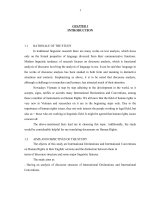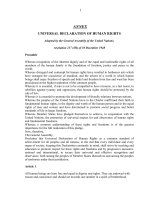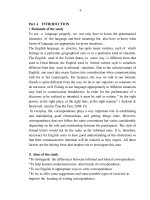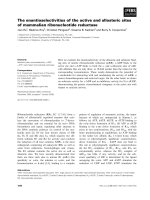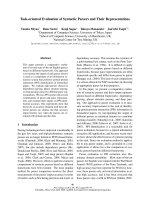Comparative evaluation of passive, active, and passive-active distraction techniques on pain perception during local anesthesia administration in children
Bạn đang xem bản rút gọn của tài liệu. Xem và tải ngay bản đầy đủ của tài liệu tại đây (685.74 KB, 6 trang )
Journal of Advanced Research (2016) 7, 551–556
Cairo University
Journal of Advanced Research
ORIGINAL ARTICLE
Comparative evaluation of passive, active, and
passive-active distraction techniques on pain
perception during local anesthesia administration in
children
Soad A. Abdelmoniem, Sara A. Mahmoud *
Pediatric Dentistry and Dental Public Health Department, Faculty of Oral & Dental Medicine, Cairo University, Egypt
A R T I C L E
I N F O
Article history:
Received 8 August 2015
Received in revised form 14 October
2015
Accepted 14 October 2015
Available online 19 October 2015
Keywords:
Active
Children
Distraction
Local anesthesia
Pain perception
Passive, Passive-active
A B S T R A C T
Local anesthesia forms the backbone of pain control techniques and is necessary for a painless
dental procedure. Nevertheless, administering a local anesthetic injection is among the most
anxiety-provoking procedures to children. This study was performed to compare the efficacy
of different distraction techniques (passive, active, and passive-active) on children’s pain
perception during local anesthesia administration. A total of 90 children aged four to nine years,
requiring inferior alveolar nerve block for primary molar extraction, were included in this study
and randomly divided into three groups according to the distraction technique employed during
local anesthesia administration. Passive distraction group: the children were instructed to listen
to a song on headphones; Active distraction group: the children were instructed to move their
legs up and down alternatively; and Passive-active distraction group: this was a combination
between both techniques. Pain perception during local anesthesia administration was evaluated
by the Sounds, Eyes, and Motor (SEM) scale and Wong Baker FACESÒ Pain Rating Scale.
There was an insignificant difference between the three groups for SEM scale and Wong Baker
FACES Pain Rating Scale at P = 0.743 and P = 0.112 respectively. The examined distraction
techniques showed comparable results in reducing pain perception during local anesthesia
administration.
Ó 2015 Production and hosting by Elsevier B.V. on behalf of Cairo University.
Introduction
* Corresponding author. Tel.: +20 1000042564.
E-mail address: (S.A. Mahmoud).
Peer review under responsibility of Cairo University.
Production and hosting by Elsevier
Effective pain control during dental treatment of a pediatric
patient is the cornerstone for successful behavior guidance
[1]. Pain is an unpleasant sensory and emotional experience
associated with actual or potential tissue damage [2]. Prevention of pain can nurture the relationship between the dentist
and the child, build trust, allay fear and anxiety, and enhance
/>2090-1232 Ó 2015 Production and hosting by Elsevier B.V. on behalf of Cairo University.
552
positive dental attitudes for future visits. However, the subjective nature of pain perception, and lack of use of accurate pain
assessment scales may oppose successful pain management
procedures [3].
Local anesthesia forms the backbone of pain control
techniques and is necessary for a painless dental procedure.
Nevertheless, administering a local anesthetic injection is
among the most anxiety-provoking procedures to children
[4]. Thus, several methods have been suggested to reduce pain
caused by administration of local anesthetic agents, and these
include application of topical analgesic, distraction techniques,
counter irritation, warming the anesthetic agents, adjusting the
rate of injection, and buffering the local anesthetic agent [5–7].
Distraction is a behavior management technique that successfully reduces pain and behavioral distress by diverting children’s attention away from painful stimuli during invasive
dental procedures. It is most effective when adapted to the
developmental level of the child. Distraction appears to be safe
and inexpensive; moreover, it can lead to the reduction in
procedure duration, and the number of staff required for the
procedure [8–10].
Distraction is divided into two main categories: passive
distraction, which calls for the child to remain quiet while
the dental health care professional is actively distracting him.
Passive distraction includes watching videos, listening to music
on headphones, reading a book to the child, or telling him a
story. Active distraction, on the other hand, encourages the
child’s participation in the activities during the procedures.
Active techniques include singing songs, squeeze balls, relaxation breathing, and playing with electronic devices [9,11].
Thus, this study was conducted to compare the efficacy of
different distraction techniques (passive, active, and passiveactive) on children’s pain perception during local anesthesia
administration.
Methodology
This study was carried out in Pediatric Dentistry and Dental
Public Health Department, Faculty of Oral and Dental Medicine, Cairo University. The ethical clearance for the study was
obtained from the ethical committee of the institution. The parents were informed about the aim of the study and associated
procedures. The written informed consents were obtained from
the parents prior to the study.
Sample size was estimated based on a previous study [12].
The minimum required sample size was calculated to be 87
(29 in each group) to be sufficient to detect effect size of
f = 0.432, a power of 95%, and a significance level of 5%.
Sample size estimation was done by PASS 2008 (Version
0.8.0.15, For Windows).
A total of 90 children aged four to nine years, requiring
inferior alveolar nerve block for the purpose of mandibular
primary molar extraction, and who had demonstrated ‘‘positive” to ‘‘definitely positive” behavior (Frankl 3 or 4), were
included in this study, regardless their previous dental
experiences.
The study sample was randomly divided into three equal
groups 30 children each: Passive distraction group: the children were instructed to listen to the same song on headphones;
Active distraction group: the children were instructed to move
their legs up and down alternatively as a sort of playing a game
Abdelmoniem SA and Mahmoud SA
together; and Passive-active distraction group: this was a combination between passive and active distraction (the children
were instructed to listen to a song on headphones while
moving their legs up and down alternatively). The distraction
techniques were employed during the administration of local
anesthesia.
The study was conducted by two pediatric dentists. One of
them gave all explanations, spoke with the children and carried
out the anesthesia procedure and the other was observing and
assessing the children’s pain perception.
Prior to inferior alveolar nerve block administration, topical anesthetic cream (PRILA 5% cream containing lidocaine
2.5%w/w and prilocaine 2.5%w/w, Middle East Pharmaceutical Industries Co. Ltd., Avalon Pharma, Riyadh-KSA, Saudi
Arabia) was applied to the injection site approximately 30 s
before the procedure. The technique used for administration
of the anesthesia involved gradual injection of 1 mL of
anesthetic agent Mepecaine-L (Mepivacaine 31.36 mg/1.8 mL
and Levonordefrin 0.09 mg/1.8 mL, Alexandria Co., for
Pharmaceuticals & Chemical Industries, Alexandria, Egypt)
using a short needle (length: 32 mm, gauge: 27) over a period
of one minute. Subsequently, extraction of the indicated
primary molar was performed.
Pain perception during administration of local anesthesia
was assessed by the Sounds, Eyes, and Motor (SEM) scale [13]
and Wong Baker FACES Pain Rating Scale [14]. Sounds, Eyes,
and Motor (SEM) scale shown in Table 1 was used to assess the
observed pain. It is divided into two categories of comfort and
discomfort. The discomfort response is further divided into
three subscales: mild pain, moderate pain and severe pain.
Wong Baker FACES Pain Rating Scale is a self-reported
pain scale, and consists of a number of faces ranging from
happy to crying. The scale was explained and shown to the
children then they were asked to point out the face which indicated the pain level they experienced during administration of
local anesthesia as illustrated in Fig 1.
Statistical analysis
Data were statistically described in terms of mean, standard
deviation (±SD), frequency (n) and Percentage (%) when
appropriate. One way ANOVA was used to compare between
tested groups on mean Age. A non-parametric Kruskal Wallis
test was used to compare between tested groups for SEM Score
and Face pain Score. Spearman’s rho correlation between
SEM Scale and Face pain Scale. Statistical analysis was performed with IBMÒ SPSSÒ (SPSS Inc., IBM Corporation,
NY, USA) Statistics Version 22 for Windows.
Results
90 children were enrolled in this study with age range from
four to nine years. The means of age in passive, active, and
passive-active groups were 7.18 ± 1.94, 7.02 ± 2.2 and 7.65
± 1.8 years, respectively. There was no significant difference
in children’s age among the three groups (P = 0.444).
SEM scale findings are presented in Table 2. Children in
active distraction group exhibited the greatest percentage
(60%) of comfort score, followed by passive-active distraction
group (50%) while passive distraction group demonstrated the
least percentage of comfort score (46.7%). However, there was
Eyes wide, show of concern, no tears
Movement of hands to make aggressive
physical contact, e.g., punching, pulling head away
Random movement of arms or body
without aggressive intention of physical
contact, grimace, twitch
Motor
No eye signs indicating
discomfort
Hands relaxed; no apparent
body tension
Eyes
Hands show some distress or tension, grasps
chair due to discomfort, muscular tension
Verbal complaint indicates
intense pain, e.g., scream, sobbing
Crying, tears running down face
Specific verbal complaints, e.g.,
‘‘OW”, raises Voice
Watery eyes, eyes flinching
No sounds indicating pain
Sounds
Nonspecific sounds; possible pain indication
Moderate pain
Mild pain
Comfort
Observations
Table 1
The Sounds, Eyes, and Motor (SEM) scale for measuring the comfort or discomfort.
Discomfort
Severe pain
Comparative evaluation of distraction techniques on pain perception in children
553
no statistically significant difference between the three groups
for SEM scale scores at P = 0.743 as shown in Table 2 and
Fig 2.
Wong Baker FACES Pain Rating Scale findings are presented in Table 3. Passive-active distraction group showed
the lowest mean of the face pain scale which was 1.67
± 2.93. There was no significant difference between the three
groups for Wong Baker FACES Pain Rating Scale at
P = 0.112 as shown in Table 3 and Fig 3.
In this study the correlations between the SEM scale
(observed pain) and Wong Baker FACES Pain Rating Scale
(self-reported pain) presented in Fig 4 revealed that there was
a significant positive relationship between SEM Scale and Face
Pain Scale scores with rs = 0.357, P (2-tailed) = 0.001.
Discussion
Pain control is one of the most important aspects in administration of local anesthesia in dental practice particularly in
children [15]. Thus, several procedural, behavioral, and pharmacological strategies have been proposed to alleviate pain
and discomfort during pediatric dental treatment.
This study was conducted to compare the effect of different
distraction techniques (passive, active, and combination) on
children’s pain perception during local anesthesia
administration.
The children included in this study demonstrated positive
or definitely positive behavior during pretreatment evaluation
(ranking 3 or 4 in the Frankl scale). The choice of the children
was based on their present behavior regardless of their previous dental experiences.
Child dental fear and anxiety are considered multifactorial
in nature. Different factors have been proposed that can stimulate, provoke and promote dental anxiety in children. These
factors include and not limited to parent–child relationship,
parental dental anxiety, parental attitudes and perceptions
regarding child’s behavior, parent’s past dental experiences,
parental presence in the dental operatory, chronological age
of the child, intellectual development of the child, medical
and dental history of the child, child’s awareness of dental
problem, and behavior of dental team. All these factors interact together affecting the child behavior, as we were examining
the efficacy of distraction techniques rather than the psychological background of the children in this study; thus, the children were selected based on their cooperation and present
behavior [16,17].
The children were not selected based on their gender as gender was not discussed by Wright [17] as a factor affecting the
children behaviors in dental clinic. Moreover, many studies
proved that there was no significant difference between boys
and girls in pain perception in children [4,8,18].
In this study, local anesthesia administration in all children
was performed by the same operator while pain perception was
assessed by another pediatric dentist in order to provide optimal standard conditions for accurate comparison between the
distraction techniques.
In the present study, inferior alveolar nerve block was
chosen to compare the distraction techniques as blocking the
inferior alveolar nerve in children was claimed to be one
of the most painful and stressful procedures in pediatric
dentistry [19].
554
Abdelmoniem SA and Mahmoud SA
Fig. 1
Table 2
Wong Baker FACES Pain Rating Scale.
Sounds, Eyes, and Motor (SEM) Scale scores for the three distraction groups.
SEM scale (n [%])
Passive distraction (n = 30)
Active distraction (n = 30)
Passive-active distraction (n = 30)
P-value
Comfort
Mild pain
Moderate pain
Severe Pain
14 (46.7%)
10 (33.3%)
4 (13.3%)
2 (6.7%)
18 (60%)
5 (16.7%)
7 (23.3%)
0 (0.0%)
15 (50%)
10 (33.3%)
4 (13.3%)
1 (3.3%)
0.743 NS
P-value: 0.743 NS (non-significant).
20
18
Percentage (%)
16
14
12
10
8
6
4
2
0
Passive Distraction
Comfort
Fig. 2
Table 3
Active Distraction
Mild pain
Moderate pain
Passive - Active distraction
Severe pain
Sounds, Eyes, and Motor (SEM) Scale scores for the three distraction groups.
Mean, standard deviation (SD), median, percentiles for the Wong Baker FACES Pain Rating Scale in the three groups.
Technique
Wong Baker
FACES Pain
Rating Scale
Mean
SD
SE
Median
Percentiles (25)
Percentiles (50)
Percentiles (75)
Mode
Min.
Max.
P-value: 0.112 NS (non-significant).
P-value
Passive distraction
Active distraction
Passive-active distraction
2.07
2.70
0.49
0.00
0.00
0.00
4.00
0.00
0.00
10.00
3.33
3.73
0.68
2.00
0.00
2.00
6.00
0.00
0.00
10.00
1.67
2.93
0.53
0.00
0.00
0.00
2.00
0.00
0.00
8.00
0.112 NS
Comparative evaluation of distraction techniques on pain perception in children
Fig. 3
555
Box-plot for the Wong Baker FACES Pain Rating Scale scores for three distraction groups.
The active distraction technique employed in this study is a
modification of a similar technique utilized by Kamath [20].
This technique appears to be simple, time saving, inexpensive
and gives rise to an effective relaxed experience in short painful
dental procedure (local anesthesia administration). Moreover,
this technique can be easily used on the large number of children attending the clinic of Pediatric Dentistry and Dental
Public Health Department, Faculty of Oral and Dental
Medicine, Cairo University.
The perceived pain during local anesthesia administration
was compared using observed ratings of pain and behavioral
distress (SEM scale) as well as self-reports of pain (WongBaker FACES Pain Scale) [21]. Observing children’s behavior
during dental treatment is essential in pain evaluation, as their
facial expressions, crying, complaining, and body movements
are important diagnostic criteria [3,14].
The use of a self-reported pain intensity scale is also beneficial for children, as this scale features facial expressions to
help the children to express how they feel. Wong-Baker
FACES Pain Scale was used according to guidelines of
American Academy of Pediatric Dentistry (2014–2015) which
recommends its use for children over three years of age due
to its well established reliability and validity [3].
The results of the present study showed that there was no
statistically significant difference between the compared distraction techniques neither in SEM scale scores nor in
Wong-Baker FACES Pain Scale scores, and this may be
related to either the operator experience, or the effectiveness
of distraction as a behavioral management technique in
minimizing procedural pain, fear, and distress by reducing
the sensory and affective components of pain [17].
However, active distraction demonstrated the greatest percentage (60%) of comfort score as evaluated using the SEM
scale, and this is because active distraction involves multiple
sensory modalities (auditory, and kinesthetic), active emotional involvement, and participation of the patient to compete
with the signals from the noxious stimuli [8].
Though, active–passive distraction combines active
engagement of the children in the distraction process together
with listening to music, this group showed a lesser percentage
of comfort score (50%) when compared to active distraction
group using SEM scale (observed pain), and this may be due
to the children’s confusion and inability to give full attention
to the employed distraction techniques. However, this
technique revealed the lowest mean of the Wong-Baker
FACES Pain Scale (self-reported pain) which indicates that
Fig. 4 Scatterplot for the correlation between SEM Scale and
Face Pain Scale.
556
the children enjoyed the dual effect of active–passive distraction by being actively involved in moving their legs together
with listening to music.
The overall correlation of SEM scale (observed pain), and
Wong-Baker FACES Pain Scale (self-reported pain) in the
three groups showed a significant positive relationship between
the two scales. Children’s ratings of their pain were directly
related to the scores recorded by the observing pediatric dentist, thereby strengthening the validity of the scales utilized
to assess the observed and the self-reported pain.
Conclusions
The examined distraction techniques showed comparable
results in reducing pain perception during local anesthesia
administration. Both SEM scale (observed pain), and
Wong-Baker FACES Pain Scale (self-reported pain) revealed
similar presentation of children’s pain perception during local
anesthesia administration.
Conflict of interest
The authors have declared no conflict of interest.
Acknowledgment
The authors would like to thank Dr. Ahmed Abdulrahman for
his statistical assistance.
References
[1] Ashkenazi M, Blumer S, Eli I. Effectiveness of computerized
delivery of intrasulcular anesthetic in primary molars. J Am
Dent Assoc 2005;136:1418–25.
[2] Second YLK, Neelakantan P. Local anesthetics in dentistrynewer methods of delivery. Int J Pharm Clin Res 2014;6(1):4–6.
[3] American Academy of Pediatric Dentistry. Guideline on
behavior guidance for the pediatric dental patient. Reference
Manual; Pediatr Dent 2014–2015;36(6):180–90.
[4] Lee SH, Lee NY. An alternative local anaesthesia technique to
reduce pain in paediatric patients during needle insertion. Eur J
Paediatr Dent 2013;14(2):109–12.
[5] Aminabadi NA, Farahani RMZ. The effect of pre-cooling the
injection site on pediatric pain perception during the
administration of local anesthesia. J Contemp Dent Pract
2009;10(3):1–9.
[6] Yesilyurt C, Bulut G, Tasßdemir T. Pain perception during
inferior alveolar injection administered with the Wand or
conventional syringe. Br Dent J 2008;E10:1–4.
Abdelmoniem SA and Mahmoud SA
[7] Leyda AM, Liena C. Comparison of eutectic mixture of
lidocaine/prilocain versus benzocaine gel in children. Open J
Stomat 2011;1:84–91.
[8] Aminabadi NA, Erfanparast L, Sohrabi A, Oskouei SG, Naghili
A. The impact of virtual reality distraction on pain and anxiety
during dental treatment in 4–6 year-old children: a randomized
controlled clinical trial. J Dent Res Dent Clin Dent Prospect
2012;6(4):117–24.
[9] Srouji R, Ratnapalan S, Schneeweiss S. Pain in children:
assessment and nonpharmacological management. Int J
Pediatr 2010:1–11.
[10] Singh H, Rehman R, Kadtane S, Dalai DR, Jain CD.
Techniques for the behaviors management in pediatric
dentistry. Int J Sci Stud 2014;2(7):269–72.
[11] Law EF, Dahlquist LM, Sil S, Weiss KE, Herbert LJ,
Wohlheiter K, et al. Videogame distraction using virtual
reality technology for children experiencing cold pressor pain:
the role of cognitive processing. J Pediatr Psychol 2011;36
(1):84–94.
[12] Aitken JC, Wilson S, Coury D, Moursi AM. The effect of music
distraction on pain, anxiety and behavior in pediatric dental
patients. Pediatr Dent 2002;24(2):114–8.
[13] Wright GZ, Weinberger SJ, Marti R, Plotzke O. The
effectiveness of infiltration anesthesia in the mandibular
primary molar region. Pediatr Dent 1991;13:278–83.
[14] Wong LD, Baker CM. Pain in children: comparison of
assessment scales. Pediatr Nurs 1988;14(1):9–17.
[15] Shahidi Bonjar AH. Syringe micro vibrator (SMV) a new device
being introduced in dentistry to alleviate pain and anxiety of
intraoral injections, and a comparative study with a similar
device. Ann Surg Innov Res 2011:1–5.
[16] Suprabha BS, Rao Arathi. Role of parent in behavior guidance
of children in dental operatory: current trends. Int J Adv Res
2015;3(1):466–70.
[17] Wright GZ. Psychologic management of children’s behaviors.
In: McDonald RE, Avery DR, editors. Dentistry for the child
and adolescent. Mosby; 2000. p. 34–51.
[18] Versloot J, Veerkamp JSJ, Hoogstraten J. Assessment of pain by
the child, dentist, and independent observers. Pediatr Dent
2004;26:445–9.
[19] Costa RSM, Ribeiro SN, Cabral ED. Determinants of painful
experience during dental treatment. Rev Dor Sa˜o Paulo 2012;13
(4):365–70.
[20] Kamath PS. A novel distraction technique for pain management
during local anesthesia administration in pediatric patients. J
Clin Pediatr Dent 2013;38(1):45–7.
[21] Windich-Biermeier A, Sjoberg I, Dale JC, Eshelman D,
Guzzetta CE. Effects of distraction on pain, fear, and distress
during venous port access and venipuncture in children and
adolescents with cancer. J Pediatr Oncol Nurs 2007;24(1):8–19.


